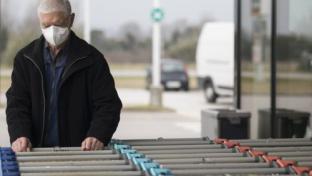Retailing Post-Coronavirus: Part 2
There are two big questions in retail today: What can we do now and how can we plan for the future? Here are answers in a follow-up to last week’s blog that incorporates great retail insider feedback.
As a World Health Organization expert said recently: “If you need to be right before you move, you’ll never win. Perfection is the enemy of the good when it comes to emergency management. Speed trumps perfection.”
Or as a local writer in my local newspaper put it: “The situation is extremely fluid just like Niagra Falls is extremely fluid.”
Retailers on the Front Lines
Today, retailers are responding to marketplace shifts they never anticipated just a few weeks ago. Shoppers are hoarding essential products and creating shortages that stress supply chains. They are also practicing self-isolation to minimize store visits, which is generating an unprecedented volume of online ordering and home delivery.
So, how high are these unprecedented levels that retailers have to cope with?
According to data from Mercatus, there has been an increase of 1,200% in online shopping account registrations and a 300% increase in mobile app downloads compared to the previous month. The spike is so high that estimates for using digital commerce within the general population will reach a level that had been predicted for 2025.
Specific product spikes include: hand sanitizers and wipes up 5,678%, household cleaning products up by 344%, toilet paper up 207%, liquid hand soap up 170%, paper towels up 122%, bottled water up 103%, canned food up 96%, vitamins and supplements up 88%, and frozen dinners up 71%.
Last week I wrote a blog that made the point that “an altered landscape will emerge for both consumers and retailers after Covid-19 passes.” You can click here to see the key points that were made.
The response to the blog was also unprecedented and many retailers sent in feedback and recommendations. Here are some of the best:
- “First, retailers need to understand the importance of demand forecasting. While it’s difficult to forecast for an event we’ve never seen before, utilizing past purchase behaviors during flu seasons and understanding the items that are impacted is beneficial information. Second, insights into inventory across the stores, as well as across warehouses, are critical to understand what items are simply out of stock on the shelf, versus completely out of stock in the warehouse. Lastly, retailers with their own private label need to consider if other supply chain resources, especially labor, will be disrupted that may impact the ability to source, receive and produce items needed to meet high demand. To be able to run optimal production is a question of both people and product, so retailers must keep this in mind when predicting lead time.” —- Shaina Finch, Head of Supply Chain Solutions Consulting, SymphonyAI
- “Retailers need to buy time until things return to normal. They need to re-examine their planning and forecasting, ordering and buying, and determine what the hole is. Then they need to manage costs to this figure.” — Anthony Karabus, CEO, HRC Retail Advisory Group
- “The coronavirus will impact inventory throughout 2020 and beyond. More and more retailers will rely on implementing a digital supply chain, which provides unified visibility to available items and supports a variety of fulfillment options. In addition, this solution can help manage raw materials so they can be quickly deployed to the factories with actual manufacturing capacity. Retailers are learning how critical it is to be prepared for crisis management, and one way to mitigate damage is to implement a digital solution that keeps their supply chain ready for whatever unexpected circumstances occur.” — Mark Burstein, President, NGC Software
- “There will be a higher emphasis on social connection and virtual group/friends shopping. This will result in an acceleration of the less physical/more virtual social experiment that millennials have already started. There will also be an extended period of sluggish sales for low priority, “do I absolutely need this” item shopping, and a surge of demand for food and basics. There may be long-term trouble for some categories that require physical gatherings, such as sporting goods and team items.” — Peter Charness, VP Retail Strategy, Just Global
- “Retailers’ advertising direction will include a heavier investment in digital media. Leading brands are planning for a new creative direction in response to the crisis — moving from a reactive approach to a proactive, contingency-based approach that builds appropriate brand communications for this protracted new reality. As store traffic began to decline in the U.S. late last week, leading brands reallocated funds to higher-performing channels. Each brand is taking a closer look at digital programs and communications in order to prepare their advertising efforts post-pandemic. Popular media platforms such as YouTube and TikTok will likely see a monumental boost as marketers reallocate budgets into digital channels, while also ensuring that any creative and copy are not insensitive or travel-related.” — Nick Drabicky, VP of Client Strategy, PMG
- “A tectonic shift in the offline to online retail. Even if a retailer happens to operate 100% online, the impact of Covid-19 will still be felt long after the pandemic has subsided. You don’t shut down the physical economy and online just goes on. You have to take into account all the people that are going to be laid off and the quick-dry up of money. There weren’t (I bet there will be in the future) contingency plans for this sort of thing. Business interruption insurance may cover some businesses that are forced to close but the payout isn’t nearly close to the value of being open. Then there is Amazon, who announced they are hiring an additional 100,000 workers (not a typo) to handle the demand spike, which then makes you wonder if the offline to online switch just got pushed from a gentle curve to a spike. Will people go back to ‘normal’ or is Amazon going to be even deeper into everything? This has ramifications for other online retailers and not just physical retailers. Obviously, those with marketplaces will be rewarded but direct-to-consumer is where it needs to be, not through someone else.” — Peter Messana, CEO, SearchSpring
- “Flexible order fulfillment will become the new norm. As consumers fulfillment habits continue to be impacted by safety regulations, order fulfillment flexibility will no longer be an advanced feature for a retailer; it will be a requirement. Post-pandemic, retailers will need to have all options – including BOPIS, curbside pickup, home delivery or delivery to lockers – readily available to consumers at all times.” – Meyar Sheik, President & Chief Commerce Officer, Kibo
- “Plan ahead for disruption: Moving forward and learning from the response to Covid-19, retailers will quickly standardize a well-defined disaster recovery plan that syncs with staff, suppliers and customers. Cleaning schedules become daily protocol: Cleanliness will become part of the daily protocol of retail operations, and placards will be made visible throughout the store to inform of an area’s last cleaning and when it is scheduled be cleaned again. More customized supply chains: The forced adoption of alternative fulfillment options will create new shopping habits for consumers. This will require supply chains built to enable direct-to-store or direct-to-consumer fulfillment more seamlessly.” — Daniel Binder, Partner, Columbus Consulting
- “When an epidemic like coronavirus arises, managers must be able to react quickly to keep staff informed about updates to location hours, staffing, scheduling, and any new health and safety training. The simplest and fastest way to ensure staff is well-informed of these changes is to create a direct line of communication from the head office to frontline workers. Fortunately, new digital workplace technology enables organizations to communicate with their workforce in an instant. A digital workplace allows the workforce to partake in collaborative action in which managers can send a message, provide training for frontline team members, and then send a follow-up survey to ensure every employee is taking precaution. This technology, which unlocks the benefits of cross-location labor sharing, real-time communication, and on-demand training, is fundamental to responding to widespread epidemics. Not only does having a direct line of communication keep frontline workers updated, but it also contributes to their peace of mind during what can be a very difficult time. — Will Eadie, Global VP, WorkJam
Consumers are depending on retailers to get it right during the Covid-19 crisis. It is up to retailers to share and implement best practices, deliver what we promise, operate responsibly, and emerge from the crisis in a strong position to serve customers in good times and bad for many years in the future.









